 |
|||||||||
Classical Editor: Rob Barnett
Music Webmaster
Len Mullenger:
Len@musicweb-international.com
|
Classical Editor: Rob Barnett
Music Webmaster |
|||||||||||||||||||||||||||||||||||||||||||||
Classical Editor: Rob Barnett, Spoken Word Editor :Gerald Fenech, Reviewers: Rob Barnett, Ian Lace, Len Mullenger, and: Richard Adams, Terry Barfoot, Arthur Butterworth, Paul Conway, Gary Dalkin, Andy Daly, Tony Duggan, Gerald Fenech, Lewis Foreman, David Frieze, Malcolm Galloway, Ian Marchant, Humphrey Smith, Philip Scowcroft, Colin Scott Sutherland, Andrew Seivewright, Richard Whitehouse, Reg Williamson, Peter Grahame Woolf, David Wright. A complete list of contributors can be seen here
March 2000 part 3 |
[Part 1]
[Part 2] [Part 3] [Part 4] [thumbnails] |
For those wishing
to print the reviews there are continuously scrolling texts
without CD cover graphics
here
© Music on the Web(UK) 2000. All rights retained. Reviewers retain
copyright on their reviews.
Disclaimer
Nielsen complete wind music Selandia Ensemble and guests
Kontrapunkt 32288 60 mins.
Save around 22% with
the retailers listed alongside
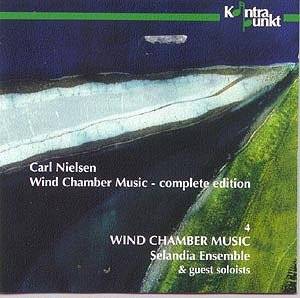
1. Wind Chm Music - Comp Edition: Fantasy Piece For Clarinet & Pno
2. Fantasy Pieces For Ob & Pno: Romanze.
3. Fant Pieces For Ob & Pno: Humoresque.
4. Canto Serioso (1913) For French Hotn & Pno.
5. Serenata In Vano (1914). for clarinet, bassoon, French horn, double bass
6. Flute Solo
7. Three Pieces Exc 'Moderen' (The Mother): No.2: Taagen Letter... No.12: Bornene Leger...No.15: Tro Og Hab Spiller...
8. Wind Qnt, Op.43:
9. Blokflojter (For Two Recorders)
This is a very satisfying programme, which has arranged itself chronologically with just the right contrast of instrumentation. After the very early clarinet Fantasy Piece of 1881, which could be by anyone, those of 1889 for oboe, Op 2, show inPiduality and are played with conviction. The Serious Song for horn (1913) was an audition test piece, exploiting the lower registers required of candidates for the 2nd & 4th horn positions in the Royal Danish Orchestra. Next, the first of the two masterpieces which have established themselves in the repertoire, the Serenade of 1914 for three winds, cello and bass, a parody of an unsuccessful intended seduction by a group of bumbling players, probably under the influence, witty and charming. An impassioned group of pieces for flute (1919/20) leads to the famous Wind Quintet Op 43 (1922) in which Nielsen characterises humorously his musician friends for whom it was composed.Well played and recorded, this is an enjoyable CD, which gives a good insight into the development of Carl Nielsen's very inPidual mature style.
Reviewer
Peter Grahame Woolf

ALAN RAWSTHORNE. Piano Quintet; Piano Trio; Cello Sonata; Concertante for violin and piano; Viola Sonata Rogeri Trio, John McCabe, Mark Messenger, Helen Roberts, Martin Qutram, Julian Rolton.
Naxos 8.554352 [DDD] [70' 05]
Save around 22% with
the retailers listed alongside

The Piano Quintet is like the curate's egg - good in parts. The opening movement is frankly tedious with all its stops and starts. But this reflects the character of the composer with whom I studied. He was a moody, difficult and changeable man. It is a lazy and boring movement. The following allegro fares better and yet the sparkle is not quite caught. Pity since Alan rarely wrote scintillating music. The performance of the slow movement is masterly in this account and pleased me greatly. The finale is so short that it is rather pointless and typical of Alan's inability to develop his material.
The Concertante is a good piece and Nadia Myerscough gives a commendable performance and has a glorious tone. But I prefer the account by Benedict Holland and Alan Cuckston on a Swintsy recording.
The Piano Trio has the same small weaknesses as the Piano Quintet... bitty, episodic, stop and start music. There are some very fine moments but some awfully drab ones. The second of the two movements is a Theme And Variations and, again, the music gets to the launching pad but never takes off!
And yet for all this the performance is excellent! Rawsthorne overcomes the usual difficulties in composition for the combination of viola and piano. It is, without doubt, his finest chamber work. It was written in 1937 before alcoholism had blighted him and when he was concerned with writing music that had vitality and impressive quality. This is a robust work and is therefore successful and the piano part has an aggressive virtuosic character.
While all composers should develop their style in order to be original and unpredictable it is a pity that Rawsthorne did not maintain the promise of this early sonata. The second movement, a scherzo was reworked to some extent in the Piano Concerto No 1 .... or, at least, the thematic material is the same. The adagio tries to be tender and, at times, almost succeeds. The finale does not work. The composer has run out of ideas. The music is too superficial and does not belong somehow.
It is over 30 years ago since Ngoc and I played the Cello Sonata to the composer. Although cast in three movements it is made up of twice as many sections. It does not have the persuasive power of the Viola Sonata but is very well written for the instruments. Alan played the cello as well as the piano, but not very well. Parts of the adagio are quite beautiful and the performers have the measure of the piece. The balance is exemplary
The disc is worth having for the sonatas.
Reviewer
David Wright
Performances
Recordings

See also earlier review by John Belcher
ALAN RAWSTHORNE Music for violin and piano; Music for piano Benedict Holland (violin) Alan Cuckston (piano)
[DDD] SWINSTY RECORDS FEW121CD
Save around 22% with
the retailers listed alongside
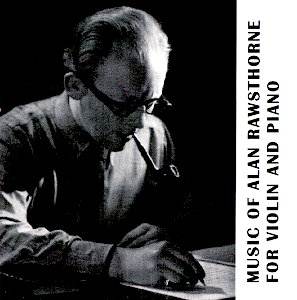
The music for violin and piano comes first. Pierrette is an attractive salon piece but hampered by the predictability of its triple rhythm which often makes music sound cheap. Predictability and reliance on formulae and devices in music is often disadvantageous.
The Concertante dates from the mid 1930s. It has some interesting harmonies and both a lyricism and classical style and concludes with some robust music. It is a good piece and is given a fine performance.
But it is the Violin Sonata of 1959 that is the prize on this disc. It does not have the power and originality of the sonata by Mátyás Seiber written about the same time but it is a serious piece in four movements. The opening movement sandwiches an allegro non troppo between adagio sections and the 'classical' clarity is admirable. The allegretto does not make an ample contrast with the first movement but the following toccata is a reasonably strong movement although this performance, good as it is, could have been more allegro di bravura.
The finale, epilogue is marked adagio rhapsodico and, in my view, is the finest movement. I admire the lyricism given to the violin, the simplicity and economy of the music and yet it is never sparse. It has a tenderness, not quite beautiful music, but approaching it.
The piano pieces begin with the Four Bagatelles of 1938 which are given a convincing performance and I am glad that some of Rawsthorne's fussy markings of tone are ignored. The opening allegro is reminiscent of Brahms' middle piano music ... consider Op 79, for example and has that often intrusive Rawsthorne 'signature tune' for example bar 34ff. Compare, for example, the Piano Concerto No 1 ... figure 16ff in the first movement. The allegretto has that Bachian clarity that Rawsthorne so enjoyed and the presto non assai has the same thumbprint but now in 6/8 time and another of his 'signature tunes' that can be detected all over his work notably in Practical Cats. The lento used to strike me as a meander but is a thoughtful piece and Bach is not far away. For the keen listener consider the Concerto in D minor for two violins as a comparison.
The Four Romantic Pieces of 1953 are really another set of bagatelles. The word 'romantic' refers to imagination of course, and the tempi of the pieces agree chronologically with the Four Bagatelles. But, by now, a worrying feature appears. Rawsthorne has some good thematic ideas but does not develop them and this is a pity and, apart from the Piano Concerto No 1 little of his piano music sparkles. It is rather 'brown' and passive.
My esteemed colleagues rate the Ballad of 1967 as Alan's best piano work. This seems to show some influence of Debussy and both the classicism of Bach and the mellow Brahms have receded. The Ballad has always caused me to consider it to be autobiographical but here is not the place to develop this conviction.
After completing the Ballad, Alan told Humphrey Searle and I that he was still searching for a personal style. And I think that sums it up. It is Rawsthorne's lack of a personal voice and identity coupled with his sometimes colourless music that many people find disconcerting.
And yet these performances should go a long way to dispel that notion. Certainly the Violin Sonata should be given a wide circulation.
Reviewer
David Wright
Performances

Recording

SARABAND FOR DEAD LOVERS, Songs and Piano Music by Alan Rawsthorne Sandra Dugdale (soprano), Martin Hindmarsh (tenor), Alan Cuckston (piano), Rene Atkinson (piano)
[DDD] SWINSTY RECORDS FEW 120 CD
Save around 22% with
the retailers listed alongside

This is an important disc.
Alan Rawsthorne's music is often heavy, intense, claustrophobic, oppressive and 'brown' in colour, as well as being cheerless and lacking in brightness. The Sonatina for Piano is a case in point as are pages of The Creel for piano duet both included on this disc.
But the songs show us a less familiar Rawsthorne. While none of them are outstanding they do reveal the composer's ease at writing for the voice. Some of the songs have an unexpected sparkle such as the Tzu-Yeh songs wonderfully brought to life by Sandra Dugdale. These songs date from 1929 and are remarkably fresh for a composer whose mature works are so passive. The sleeve notes refer to Infant Joy 'revealing the composer's unmistakeable voice' but unmistakeable does neither mean outstanding nor innovative. The Three French Nursery Songs had Sophie Wyss as their first performer in 1938, which is some commendation as, in fact, was the case of Nous etions trois filles.
Alan Rawsthorne was notorious for hijacking other men's wives and friends. It was part of his longing to be both loved and admired and his jealousy at friendships that others had. His lack of self-esteem found dubious comfort in excessive alcohol; and this may well explain the muddled and morose content in his music. He courted the favour of two poets, Louis McNeice and W.R. Rodgers who were both great friends of Humphrey Searle.
Rawsthorne's setting of McNeice's Precursors and Rodgers' Carol seem to miss the point and the latter, in the key of B flat minor, does not suit.
Rawsthorne also hijacked other composers' music. The Chaconne in his Piano Concerto No 1 is a piece called Ostinato which Denis ApIvor wrote some six years earlier and did not publish.
The Saraband for Dead Lovers is a setting of words by Walter Meade using the melody from the 1948 film of the same name which film starred Stewart Granger, Flora Robson and the delicious Joan Greenwood whose plummy voice still haunts me.
In spite of my reservations about the quality of the music this disc is significant and includes all of Alan Rawsthorne's solo songs.
The performances and recording are good. I felt that Martin Hindmarsh's voice sounded a little tired occasionally but this is probably because of 'many takes' since he is a perfectionist. Alan Cuckston's playing is as reliable as ever.
Reviewer
David Wright
Performances

Recording

RIMSKY KORSAKOV Piano Trio in C minor (1897); MUSSORGSKY Pictures at an Exhibition (arr for piano trio by the Bekova Sisters) Bekova Sisters
Chandos CHAN 9672 [DDD] [77' 45"]
Save around 22% with
the retailers listed alongside

This is a curious disc.
The idea of Pictures at an Exhibition scored for piano trio is laughable unless both the cello and the violin have equal parts with the piano which, in this arrangement, they do not. In the main, the string parts reinforce the piano part but when the keyboard is silent the string parts seem lost. There are some scratchy string tremolos and ugly quasi glissandi and often the strings have nothing to do but seem to come in haphazardly as if at a rehearsal. Some of the string effects are most off-putting and absurd. You will either love it or hate it and the final movement The Great Gate at Kiev will decide it for you if you need to wait that long.
Generally, Rimsky's Piano Trio is a warm, leisurely piece reminiscent of Brahms's late glowing style. It is a substantial piece lasting 45 minutes and, while it is not great music, it is often beautifully written. Apparently, Rimsky's son-in-law, Maximilian Steinberg completed this work shortly before the outbreak of the Second World War, some thirty years after Rimsky's death.
Rimsky is not remembered for his chamber music but there is a String Quartet of 1875, a String Sextet and a Quintet for piano and wind, both dating from 1876. By the time of this Piano Trio, he had produced six operas including a setting of Pushkin's poem Mozart and Salieri, three symphonies, a piano concert, the popular Spanish Caprice and the hackneyed Sheherazade. And so, the Piano Trio is a late work.
This was written four years after the death of Tchaikovsky whose Piano Trio in A minor, Op 50 was written 'in memory of a great artist'. (The Bekova Sisters have recorded this on Chandos CHAN9719). By the time Rimsky came to write his Trio, Borodin and Tchaikovsky were both dead and this may explain why this work is elegiac as seen, for example, in the slow fugal introduction to the finale. The reliance on such a device is the only disappointment in this work. The rest of the finale is controlled high spirits although fugal devices reappear. Eight minutes or so into this movement we have a glorious lyricism and a melodic line second to none. This music breaks down somewhat after this with a loss of momentum and another fugal device but, thankfully, the 'happy' music returns.
There is a great deal to enjoy in the Rimsky. The performances are good and the recorded sound most admirable.
Reviewer
David Wright
Performances

Recording

EDMUND RUBBRA MUSIC FOR VIOLIN AND PIANO Sonata No 1 Op 11 (1930) Sonata No 2 Op 31 (1932) Sonata No 3 Op 133 (1968) Four Pieces Op 29 Variations on a Phrygian Theme for solo violin Op 105 Krysia Osostowicz (Violin) Michael Dussek (Piano)
DUTTON CDLX 7101
Save around 22% with
the retailers listed alongside
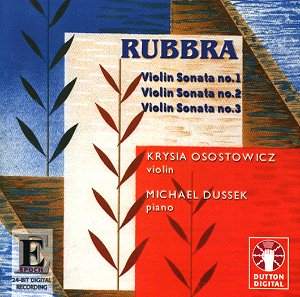
This disc fills a gap in the expanding Rubbra discography and is very welcome, being sensitively played and beautifully recorded. Only the Second Sonata has been recorded before and that, at least three times:-
1. Albert Sammons and Gerald Moore c.1941 the only work Rubbra had recorded before about 1950
2. Rubbra with Kantovich c.1950
3. Llyn Fletcher in 1992 for Dervorguilla (CD104, Rubbra Chamber Music).
The First Sonata (c 1930) remains unpublished and, from Rubbra's point of view, one can see why as he probably felt that it lacked stylistic unity. The first movement is reminiscent of John Ireland and the third is a curious chromatic fugue which shows the influence of Rubbra's loves at that time, Cyril Scott and Scriabin. Speaking of 'loves', it was written for Antoinette Chaplin who became the first Mrs. Rubbra in 1931. It is a beautiful work, especially the second movement, and deserves to be published. I can only recall hearing it once before, in a broadcast about ten years ago with Eric Gruenberg accompanied by our own John McCabe.
Rubbra always writes beautifully for the violin. There is also the Violin Concerto (1958) and the Improvisation for Violin and Orchestra (1956). Rubbra in fact had lessons on the instrument for many years from his piano teacher's wife, Grace Howard-Jones (nee Thynne).
It is worth saying that these works do not quite qualify as the complete music for violin and piano as, although the disc is just less than an hour long, the Op 144 Five Graded Pieces written for the Guildhall School of Music's examinations (Rubbra was for a while on the staff there) are curiously omitted. They have a similar purpose to the lovely but equally didactic Four Pieces Op 29. I do hope that young players might be exposed to these now that they can be heard on CD. For anyone not convinced that Rubbra could write a tune just listen to No.3 the Slow Dance.
Of course, early Rubbra, by which I mean the Rubbra works dating from the period which culminates in the incredibly exciting 1st Symphony (1937) almost seems like a different 'animal' from the later Rubbra. The Second Sonata (1932) includes a wild Spanish type dance, which is like nothing else in Rubbra's output. Ralph Scott Grover in his excellent book 'The Music of Edmund Rubbra' (Scolar Press 1993) talks here of Bartokian influence. Bartok was a composer Rubbra greatly admired and spoke to me about on several occasions. Here the sonata is superbly played and Osostowicz who never relaxes the tension and is slightly faster than Llyn Fletcher.
The Third Sonata (1968) is a masterpiece, a superbly blended cross between the improvisatory and the schematic. Lewis Foreman, in his excellent notes, describes it as enigmatic, but having been closely acquainted with the piece now for 25 years I feel that it has a strength of design and character that only slowly grow on one. I wonder how long these performers have known it. They play with great assurance and confidence. The work was first heard in 1968. Incidentally I must contradict the comment made by Scott Grover that the Third Sonata was not played in London until the Wigmore Hall performance of 13 June 1985. When Rubbra retired from the Guildhall in 1975 his students, including myself, organised a farewell concert for him on 26 March in which David Butler and Robert Penkett played the Third Sonata. The composer was present.
The Variations make a compact and elusive work: 12 variations and a coda packed into 6 minutes. It demonstrates Rubbra's unique view of variation form where there is a greater sense of metamorphosis than of strict variation. The variations were written for Frederick Grinke, a fine player who had promoted Rubbra' s earlier sonatas.
Reviewer
Gary Higginson

Schumann Liederkreis Op. 24, Belsazar, Romanzen & Balladen Op 49, 53 & 64 Nathalie Stutzmann (contralto) Inger Sodergren (piano)
BMG 09026 68900 65'53"
Save around 22% with
the retailers listed alongside
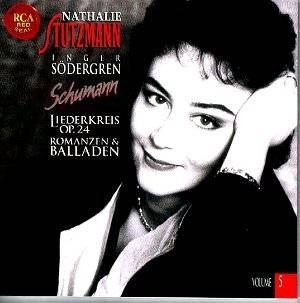
This is a disconcerting CD from an admired singer. The first Liederkreis song cycle is fairly well sung, but I found the pianist not imaginative and sometimes heavy-handed. Belshazzar is a compelling version of the feast in Babylon and the writing on the wall. The Romances & Ballads are less well known (apart from the Two Grenadiers from Op 49) and there does not appear to be another complete recording of them available. They are variable in interest and quality, and so is the singing. Sometimes pitch is dubious, the voice a little strained, and vibrato spreads. I suspect there was a problem and that Natalie Stutzmann was out of voice during part of the session, which were spread over 5 days during 1997.
Most of the songs are really intended for male singers, and better left so. The list of nearly 20 current recordings of Liederkreis, almost exclusively by male singers, including leading lieder singers past and present, indicates the stiff competition (though I'm sure Brigitte Fassbaender's recording would be worth hearing - she used to successfully challenge her male colleagues on their own ground).
This release cannot be considered competitive and I cannot recommend it, even to Stutzmann's admirers.
Reviewer
Peter Grahame Woolf

VARIATIONS. Schumann Impromptus Op 5; Beethoven Variations; Schubert Variations (world première recording); Ghost Variations. Brahms Variation on a theme of Schumann Andreas Boyde (piano)
ATH CD23 [DDD] [67' 16"].
Save around 22% with
the retailers listed alongside
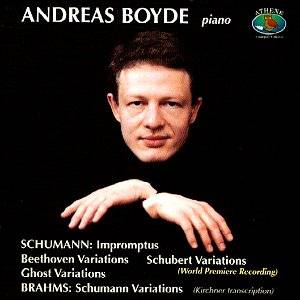
This is an important disc as it includes the world première recording of Robert Schumann's Variations on a theme of Schubert painstakingly reconstructed from manuscripts by the pianist on this recording, Andreas Boyde.
In his excellent booklet Boyde explains Schumann's admiration for the music of Scubert. It is known that in 1838 he visited Vienna and discovered the manuscript of Schubert's Great C major symphony which he sent to Mendlessohn suggesting, or implying, that Mendlessohn should conduct it. Other experts on the life and music of Schumann do not wholly support the notion that Schumannn adored the music of Schubert but rather, in his tragic mental state, was confused and, in some strange way 'wanted to change places with Schubert' convincing himself that Schubert was a great composer and that he was worthless.
It is this tragic mental illness that dogged Schumann all his life. Whether he was a manic-depressive as well as a tortured schizophrenic may be open to medical debate. Some of the criticism of his music is harsh. Piano works like Kreisleriana and Faschingsschwank aus Wein are among the piano classics and, despite the criticism of his orchestration, so also are works such as the Symphony No 2 (listen to the recording by Ricardo Muti), the flawless Piano Concerto (acquaint yourself with the recording by Peter Katin), the exhilarating Konzertstück for 4 horns and, when played well and the tender Cello Concerto of 1850. His three quartets and the Piano Quintet in E flat are, in my view, splendid chamber works and I value his songs and vocal duets (investigate the Julianne Banse and Brigitte Fassbaender recordings) higher than those of Schubert.
The Waltz of Longing by Schubert which Schumann uses was, apparently, a popular tune and Schumann had used it in the opening of Carnaval Op9. It may not be a tune of great depth but that could also be said of the theme by Diabelli which Beethoven was to use.
I was brought up on the scholarship that Schumann had an infatuation with Anges Canus who, in turn, admired Schubert and to impress her he espoused a love for Schubert. Perhaps modern scholarship will refute this but, as a psychologist, I believe this to be so since inherent in many of Schumann's works are musical references to the many women he loved.
The Variations on a theme of Beethoven, completed in 1833, are a far better set ... perhaps because the theme, the allegretto from the magnificent Symphony No 7 in A, is vastly superior. There is some very fine music here although the final minutes may appear to be gloomy to some people. I do not have the score but the performance seems totally convincing.
The Ghost Variations (Variations on an original theme) are also rewarding. They were written at the end of Schumann's tragic life when he was hearing the voices both of angels and demons. Strangely the music ha a sublime religious feel, an uncanny peace and resignation in this beautifully crafted work. Clara Schumann did not want this work published. Brahms, a loyal and honourable friend of Schumann, respected her wishes but composed his own Variations on a theme of Robert Schumann Op23 for four hands. Here Andreas Boyd plays the transcription for solo piano by Kircher. Brahms' work, arguably the best on the disc, is a labour of love and a tribute to Schumann and to Clara whom he also adored. Brahms said that Schumann's Ghost Variations was his friendly farewell.
I found the Impromptus Op 5 to be somewhat slight. They may show Robert's love for his beloved Clara and bear many of his hallmarks.
Boyde is a superb player. We have heard his virtuosic power in the Tchaikovsky Piano Concerto No 2 (ATH CD 16) and his performance of Ravel's fiercely-difficult Miroirs (ATH CD 17) is simply stunning. Here in this disc there is tremendous insight into this music and the Brahms performance gives a very rare satisfaction.
Reviewer
David Wright
Performances

Recording

Schnittke, Pärt, Penderecki, Lutoslawski, Gubaidulina etc . Roman Mints (violin) Evgenia Chudinovich (piano)
Black Box BBM1025 65 mins
Save around 22% with
the retailers listed alongside
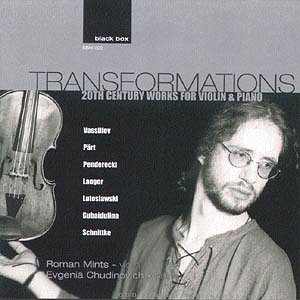
This fine Russian violinist, who studied at the Royal College of Music in London, came to notice with a memorable appearance in the PLG Young Artists series (reviewed in Seen&Heard, January 2000). His debut CD, made when he was just 23, covers similar repertoire.
I'm not greatly enamoured of minimalism, but Mints made a better case for Pärt's Fratres (which exists in numerous arrangements) than most other performances I have encountered. Vassiliev's short pieces traverse a wide expressive range, as does Penderecki's 1959 Miniatury. Lutoslawski's virtuoso display piece Subito is one of the composer's last works, with 16 finalists at the 1994 International Violin Competition in Indianapolis all credited with its first performances. Gubaidulina's Dancer on a Tightrope explores amazing sounds inside the piano, produced with a glass tumbler on the strings. Least known of the composers represented is Elena Langer, whose Transformations were revised for Roman Mints in 1998. To end, Schnittke's sour and grotesque distortion of Silent night makes a bizarre and thought provoking conclusion to a fascinating recital.
Elena Chudinovich, a child prodigy from the Ukraine, also studied in London, winning the Premier Prix at the Guildhall School of Music. Her contributions to this very personal recital programme are equally impressive; two young artists to watch!Black Box's recording is impeccable and their stylish presentation, in black, white and silver, is both informative and a pleasure to handle. A very desirable CD.
ReviewerPeter Grahame Woolf

SHOSTAKOVICH String Quartets Nos 4, 6 & 8 St Petersburg String Quartet
Hyperion CDA67154 70m DDD
Save around 22% with
the retailers listed alongside
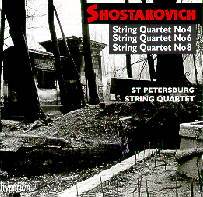
The second volume in what is appearing to be a ground breaking series of Shostakovich String Quartets from Hyperion brings together a trio of even numbered works that cover the decade from 1949 to 1960. The first two are in four movements whilst the last composition has five bitterly concentrated movements indicating a marked preference for severity of form. I would rate the Sixth as the greatest of these works not just for its abundance of striking ideas but also for that memorable final movement, a sardonic play on notes surely with the oppressive dictator in mind. These works are confessional outpourings of grief and deep human trauma and thus could be seen as intimate diaries of one who disappeared, in a metaphysical sense. The Fourth is also imbued with a high sense of personal tension especially in the long brooding Andantino with its almost fragmentary like construction, all conveys void and despair. With the 8th Quartet we are on altogether more spirited ground although as I mentioned earlier there is a severity of form that signals some strong undercurrents. In all three quartets, the St Petersburg ensemble is thrilling, just sample their daredevil tricks in the opening Allegretto of the Fourth and the dazzling Allegro molto of the Eighth, this is indeed great playing. Comparing them with the stately Fitzwilliam String Quartet revealed some shocking differences and I was always more moved by the Russians' inimitable sense of palpable authenticity. Add all that to a perfectly satisfactory recording and you have a disc that should be listed as a definitive version of Shostakovich's 'Intimate Letters'. Next instalment please!
Reviewer
Gerald Fenech
Performance:

Sound:

SHOSTAKOVICH Violin Sonata PENDERECKI Sonata for violin and piano PART Spiegel im spiegel SCHNITTKE Sonata No. 3 for violin and piano, Stille nacht (Silent night) Daniel Hope: Violin, Simon Mulligan (piano)
Nimbus NI5631 68m DDD
Save around 22% with
the retailers listed alongside
Four modern composers and predictably this disc is a veritable audible challenge but can have its rewarding moments as is is amply demonstrated by Hope and Mulligan. The Shostakovitch sonata contains some deeply emotional moments rather in the mould of his Third Quartet, the three movements are extremely soul searching and personally deeply felt The wonderful opening Andante is quite magnificently played by Hope who negotiates all the notes with a corporate attack that enhances the music's power of suggestion. I was also deeply moved by the desolate and barren third movement marked Largo-Andante where the solo violin takes on an almost hallowed sunset-like quality. The same could not be said for Penderecki's Cadenza for Solo Violin, which exploits the dissonant textures of the violin to the point of sheer discord. With Part's lovely mirror work we are back in the realm of the holistic and Hope is unchallenged in his spiritual intensity. Schnittke is another towering colossus of the 20th century and his severe Third Sonata contains a movement marked 'Senza tempo', typical Schnittke but captivating in the best sesnse.
Throughout the disc, Daniel Hope and Simon Mulligan play with a demonic intensity and astounding technical ability that continue to confirm their status as one of the best chamber partnerships around in the sonata repertoire. The extensive notes by Hope lets us into the true meanings of these strangely beautiful works. As a monument to the artistic icons of twentieth century sonatas this disc is essential, indeed indispensable.
Reviewer
Gerald Fenech
Performance:

Sound:

JENNIFER BATE plays British organ music STANFORD AND HIS CONTEMPORARIES Including PARRY, Toccata and Fugue Jennifer Bate (organ)
ASV QUICKSILVA CD QS 6222
Save around 22% with
the retailers listed alongside

Like any long-serving Cathedral music director I have performed the music of Stanford and Parry on innumerable occasions with devotion and affection. All the same a CD of music by Stanford and his contemporaries could look like something of a grey area, peopled by non-too-eminent Victorians and Edwardians.
Fortunately the title is misleading, and the list of featured composers runs into the mid-20th century and beyond, including Bairstow, Cocker, Harris, and even a couple of Whitlock pieces (Pertimento and Carol, played with haunting Delian beauty at St. James', Muswell Hill). This is one of three instruments used: the others, St. Andrew's, Plymouth, and The Brangwyn Hall.
A lion takes pride of place on the cover - The British Lion courtesy of SB pictures. It seems appropriate. for this is a collection of British music played on the right sort of instruments in suitable colourful, romantic style. Listen for example to the two Bairstow tracks to see what I mean: the Prelude full-blooded with reeds and diapasons, and the Evening Song so warm and evocative. There are old favourites such as Norman Cocker's Tuba Tune in an inspirational performance, and three of Stanford's lesser known Op. 88 Preludes, beginning with the delightful one 'in form of a minuet' (delicious fluting sounds )
Stanford's exciting Fantasia and Toccata begins this 78 minute sequence of pieces with scarcely an unattractive number among them. (I haven't warmed to the Wood Prelude yet but may well do so). Harris's two short pieces, unknown to me turned out quite charming.
An all-round winner this CD, with some wonderful playing most realistically captured. Highly recommended.
Reviewer
Andrew Seivewright
and a review of the same disc by Rob Barnett:-
Jennifer Bate positively revels in the elaborate musculature of STANFORD's Fantasia and Toccata; the latter rivalling Reger. The 'Oirish 'Bhoyo's' Op. 88 numbers 1-3 agreeably round out the recital. However Stanford's music is by no means the most notable aspect of this anthology.
The WHITLOCK Carol and Pertimento overlap with the third (all-Whitlock) disc in this trio of ASV QUICKSILVAs. The Carol draws on a complex and light-handed palette while the Pertimento celebrates in mercurial sentimentality. HARVEY GRACE's Psalm Tune Postlude on Martyrs is a dignified stroll. Parry's famed Wanderer Toccata and Fugue reaches across time and borders to Franz Schmidt's organ works (nicely recorded on Hyperion). CHARLES WOOD's vivid imagination makes his Prelude on St Mary's one of the stand-out tracks on this disc. Its darkly magisterial tread verges on the Gothic. GORDON JACOB lights up the hill-top beacons and cathedral windows with his Festal Flourish - typically talented and brilliant in effect. W.H HARRIS is represented by his flighty A Fancy and the soulful Reverie. BAIRSTOW, the celebrant, is featured in the Prelude in C and his fertile imagination is represented by his delightful Evening Song.
Three different acoustics are encompassed by this disc: the Brangwyn Hall, Swansea, St Andrews Parish Church, Plymouth (Whitlock's Alma Mater) and St James's, Muswell Hill, London. The essence of British concert and ecclesiastical organ music caught in this and the Elgar disc. An attractively priced (bargain range) issue.
Reviewer
Rob Barnett

STRAUSS Metamorphosen, Capriccio sextet, SCHONBERG Verklarte Nacht. Brandis Quartet with Walter Kussner, Dietmar Schwalke, Rainer Zepperitz
Nimbus NI5614 66m DDD.
Save around 22% with
the retailers listed alongside

These are beautifully played arrangements of works known better in their orchestral guise. 'Metamorphosen' is a deeply felt elegy generally recorded for '23 solo strings' as intended by the composer but seven instruments also carry significant weight as the Brandis Quartet and their partners demonstrate.
The deeply mournful mood of the music is played with exemplary finesse by these seven artists who are after all some of the best string players in the world. Compared with Kempe's lusciously vivid account with the Staatskapelle Dresden (a fine example of virtuosity) this brightly recorded interpretation may seem to be skeletal but deeper listening is rewarding.
I was also familiar with the deep lush sonorities of Karajan's 'Verklarte Nacht' in his incomparable mid seventies DG recording but this soul searching version has something to commend it, particularly in the mournful lines of the solo violin or the bold statements of the sextet in unison.
The solo instruments make their intriguing case as the music unfolds in all its late romantic grandeur, a study in music on the brink of tonality. After the whole performance, this listener was amazed by the utter perfection of the Brandis Quartet, a shining example of glorious chamber playing. It's a refreshing alternative to the grandeur of the orchestral version.
Finally we have a short rendition of the Prelude to 'Capriccio' in sextet form, more delicious playing and an ideal end to what is a stirringly profound disc. As a different look at more familiar orchestral works this disc makes an ideal entry into the library of twentieth century chamber music performance.
Reviewer
Gerald Fenech
Performance:

Sound:

DONALD SWANN The Isles of Greece - a cycle of songs for voices and chamber orchestra plus Donald Swann accompanying himself in The Casos Sonnets.
Lucinda Broadbridge (sop) Juliet Alderdice (mezz) Jeffrey Cresswell (ten) with instrumental accompaniment/John Jansson.
PINE ART 2-5010 [77.41]
Save around 22% with
the retailers listed alongside
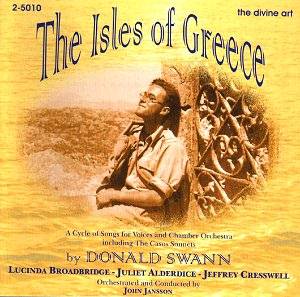
Donald Swann (1923-94) is particularly remembered for his shows with Michael Flanders (At the Drop of a Hat, etc.) but his genius was many sided and this CD will extend the knowledge of his music for many people.
Swann got to know the Greek islands at the end of the Second War, especially Casos in the Dodecanese. This was reflected in his music from time to time and this well recorded CD seeks to draw together Swann's Greek strands. Some of the tracks are arrangements of traditional songs, mostly sing in Greek, others are varied original settings by Swann of Greek poems, mostly sung in English, of which I particularly enjoyed the delicious Miranda, which often figured in At the Drop of a Hat, the charming dialogue The Favours and the stark The Isles of Greece. The three singers, admirable in their clarity of diction and delivery, are all well suited to this repertoire and they are accompanied by a chamber orchestra, a solo soprano saxophone contributing some evocative moments.
The arrangements, including the purely instrumental Casiot Journey are by Mr. Jansson, who also sets the folk song Militsa which Swann did not set but much enjoyed. Swann returned to Casos in 1986, wondering if the spell it cast would have dissipated (it hadn't); the eight Casos Sonnets represent his thoughts in words and music of that journey. All are here, sung by Swann himself to his piano accompaniment, as a bonus II-VII, which also figure sung by the three "modern" singers. Their idiom is often recitative-like but is nevertheless deeply felt. Pine Art's relatively small catalogue has afforded several items of unusually interest, many of them British. This is certainly one of them and I am happy to give it a warm recommendation.
Reviewer
Phil Scowcroft

see also earlier review by Rob Barnett
EXPOSÉ - the chamber works of PETER TAHOURDIN: Dialogue no 1 (1971) for violin and piano; Raga Music 1 - The Starlight Night (1985) for soprano and ensemble; Dialogue No 4 (1984) for trombone and percussion; Songs of Love and Fortune (1992) for baritone and piano; Raga Music 4 - For Two (1991) for bass clarinet and percussion;Expose (1995) for solo piano Kirsten Williams, Michael Harvey, Jeannie Marsh, Gerald Gentry, Frederick Shade, Rudolf Osadnik, Arturs Ezergailis, Peter Neville, Barrie webb, Julian Warburton, Bradley Daley, Phillipa Safey, Carl Rosman
MD 3205 Move Records 10, Glen Drive, Eaglemont Victoria 3084 Australia
Tel: (03) 9497 3105 Fax: (03) 9497 4426
http://www.home.aone.net.au/move
Save around 22% with
the retailers listed alongside
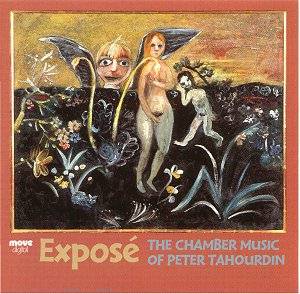
Peter Tahourdin (born in 1928) studied with Richard Arnell at Trinity College of Music, London. Settling in Australia in 1964, he became visiting composer to the University of Adelaide. There, five years later, Tahourdin established the first practical course in electronic music in Australia. In 1973, he was appointed lecturer in composition at the University of Melbourne's Faculty of Music. The earliest piece in Peter Tahourdin's current catalogue of works is the Sinfonietta no1 of 1952. This was followed by a second Sinfonietta in 1959. Both these attractive, well-crafted light orchestral works are still available on hire from Peters Edition. He wrote his first symphony in England in 1960. This closely-argued and immensely enjoyable tonal symphony proved the composer's natural gifts as a symphonist. Indeed, he has written four more examples in the genre (1969, 1979, 1987 and 1994). All have received performances with the exception of the fifth which is still awaiting its premiere. They constitute important markers in the composer's career and deserve wider dissemination through performances, broadcasts and recordings. His other compositions range from orchestral to choral, stage works (including a one-act opera, "Inside Information" (1955) and a one-act ballet, "Illyria" (1965)), electronic pieces, instrumental works, pieces for tape and educational works (including a one-act opera for children, Parrot Pie (1973). Scores and performance material of the compositions of Peter Tahourdin may be obtained from the Australian Music Centre PO Box N690, Grosvenor Place, NSW 1220, Australia Tel: 61-2-9247 4677 or Fax: 61-2-9241 2873.
This CD includes an impressive cross-section of his chamber pieces covering a span of 24 years. All the works assembled on the disc are strongly argued, demanding and repaying repeated hearing. The language is atonal and sometimes uncompromisingly tough but the musical arguments are not difficult to follow. They merely require concentrated listening. The CD includes two attractive vocal works (Raga Music 1 of 1985, an exotically scored creative interpretation of Gerard Manley Hopkins' "The Starlight Night" and Songs of Love and Fortune, a vibrant 1992 setting of five poems from the Carmina Burana). The purely instrumental works are tougher nuts to crack but the idiomatic writing bespeaks musicianship of the highest order. The two atmospheric pieces from the Raga music series are based structurally on the slowly unfolding raga of North Indian classical music. The two dialogues take the form of a discussion between two musicians, including virtuosic cadenza-like episodes for both players at the climax of each piece.
An appetising entrée to the music of Peter Tahourdin, this CD has made me want to hear his works for larger forces (the five symphonies in particular) in modern digital recordings of the calibre of the present release. At over 70 minutes' duration, the disc is well filled and the performances are all imaginative and reveal considerable interpretative insight, especially Jeannie Marsh in the taxing soprano part of "The Starlight Night". Recommended with enthusiasm as a rare opportunity to sample the inPidual soundworld of a composer who has been sadly and unjustly neglected by the musical establishment in the country of his birth.
Reviewer
Paul Conway

JOAN TRIMBLE: Two Pianos - Songs and chamber Music Various Artists
Marco Polo Irish Composer Series. 8.225059
Save around 22% with
the retailers listed alongside
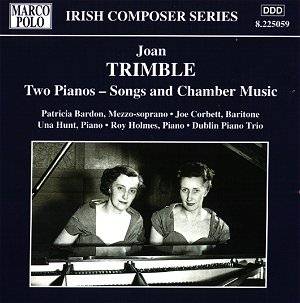
.
Enniskillen-born Joan Trimble (1915-) studied at the Royal Irish Academy and, later , at the RCM and is best remembered for her two-piano partnership with her sister Valerie - a famed duo which remained in being over 30 years. Joan, however, has always had a talent for composition and it is good to have this well recorded CD which gives a fair sample of her work (which also includes an opera for TV and a fairly recent Wind Quintet). Naturally enough, music for two pianos, skilfully played here by Una Hunt and Roy Holmes, looms large in the CD.
We begin with three Irish folksongs in arrangements whose exuberance recalls Percy Grainger; many of the other two-piano pieces have an Irish flavour, too, even if they are not folk arrangements as such: Buttermilk Point, a reel, The Bard of Lisgoole and the "hop-jig" The Humours of Carrick, all among the earliest pieces written for the Trimble duo (for which Arthur Benjamin composed Jamaican Rumba); and even the delicious short tone poems Puck Fair and The Green Bough. Less Irish, yet still attractive, are the mildly astringent Sonatina and Pastorale-Hommage à F. Poulenc, inspired maybe by the Frenchman’s Movements Perpetuels. The Phantasy Trio performed by the Dublin Piano Trio, is rhapsodic and rich in harmony, very much in the English (or should that be British?) pastoral tradition, still strong in 1940. The song cycle The County Mayo was written for that fine Irish baritone Robert Irwin, whom I remember with pleasure; Joe Corbett does well in it here. It is unusual in having a two piano accompaniment and it is a measure of the composer’s skill that mostly it sounds rich rather than merely thick. Three other songs are pleasantly sung by mezzo Patricia Bardon. The well-produced booklet prints the words of all seven songs and all in all this is a disc well-worth exploring. Trimble is to a considerable degree a "light music" composer, but is none the worse for that.
Reviewer
Phil Scowcroft

MANFRED TROJAN (1907-83) Fairy Tales and Folk Songs Prince Bajaja (1950 arr 1970) [21.55] The Emperor's Nightingale (1948 arr 1964) [21.22] Czech and Slovak Folk Songs [15.54] Václav Hudecek (violin) Pavel Dreser (accordion) Lubomir Brabec (guitar)
rec 4-6 March 1994, Prague SUPRAPHON 11 2203-2 131 [59.26]
Save around 22% with
the retailers listed alongside

A collection of arrangements for a trio may not sound the most appetising of confections and yet if you do not hear this disc you miss out on an experience of miniature yet vivid enchantment.
Only two of the items are film music and these two are arrangements of music written for animations from the bleak Czechoslovakian days of 1948 and 1950. The visual style recalls some of the efforts in the recent BBCTV series of half-hour Shakespeare animations - collaborations between Russian TV and BBC Wales.
The CD leaflet carries three colour photos from the two films. The music and the appearance of the films reminds me of the Czech animations I used to watch as a child on early 1960s TV - series such as The Singing Ringing Tree and other warmingly strange fables.
The two films were the work of Jiri Trnkas whose other animations include The Good Soldier Schweik, Spalicek (Martinu wrote a ballet on the same subject), Legends of Old Bohemia and Midsummer Night's Dream.
The Prince Bajaja suite employs music that is husky, sadly antique, brooding with pavane-like reflection. Its sound-world is that of some miniature fairground amid a bonsai forest lit with child's candles and Chinese lanterns. Elizabethan dumpes and Susato's Danserye also stalk this lost courtly world. Bajaja and the Dragon is lightly macabre and the final section of the suite reels with the intoxication of the violin's song hand in hand with the Mendelssohn violin concerto.
The Emperor's Nightingale has a quasi-Oriental charm. The nightingale speaks through the violin's song, high in pitch and sweetly intoned like the music from Sibelius' Humoresques. The Imperial Swans are depicted in a light wash of beautiful sound. Other memorable voices and moments include Viennese gemütlichkeit, Mozartian dances, an Emperor's March on which you can warm your chapped hands, non-cloying sentimentality and the pinched song of an automaton nightingale.
The folk song arrangements take us through many worlds: high pastures, village polkas and round dances, bierkeller cheer with foaming steins, nods, winks and snores and the ecclesiastical sincerity of the Wenceslas hymn (best known for Suk's Meditation for strings - every bit as strong as the Barber Adagio) and the Tziganery of the final song: Four Girls.
The music is recorded as arranged for a trio of violin, guitar and accordion. This is sound is bound to remind you of the Viennese Schrammel brothers' ensemble of two guitars, violin and accordion. Trojan magics from the trio a great host of crystalline clear sounds and emotional apparatus.
So: had your fill of Herrmann? Suffering Waxman burnout? OD'd on Korngold? Sated on Williams? Glutted with Goldsmith or exhausted by Rózsa? If so why not broaden or vary your horizons with the palate cleansing clarity of this fine Czech composer's film music.
The span of film music is so much broader, richer and varied than Hollywood and Ealing might suggest. The Iron Curtain countries produced hectares of material and who is to say that it is to be dismissed en masse as shallow flag-waving and superficial tub-thumping? There is none of that in these Trojan pieces.
Trojan's musical imagination is bright and dun - shadow, shade and brilliance. These fairy-tale fantasy visions are delightfully naïve and well worth your attention. Recommended.
Reviewer
Rob Barnett

PS I hope to review a Supraphon collection of Czech orchestral film music at some stage.
TRUSCOTT Symphony, Suite in G and Elegy National Symphony Orchestra of Ireland, cond. Gary Brain
Marco Polo 8.223674 (60' 52")
Save around 22% with
the retailers listed alongside
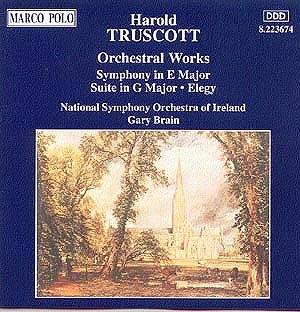
Harold Truscott (1914-1992) was largely self taught, but achieved an encyclopaedic knowledge of 19th & early 20th Century music. He taught at Blackheath Conservatoire and Huddersfield Polytechnic (now University) and wrote widely and provocatively. He was also well known as a broadcaster. Although he composed throughout his life this aspect remained less publicly known. I had the privilege of getting to know Harold well in his last years of failing health at Deal, due to a shared interest in Franz Schmidt, and he always regaled us with a fund of memories and opinions. Harold was also extremely knowledgeable about early film.
Harold Truscott continued to write and completed a first volume of The Music of Franz Schmidt (Toccata Press) but he was frustrated in efforts to get access to some of the original Schmidt scores and documentation needed to complete the project, and turned instead to a major study of Mendelssohn, which likewise remained uncompleted. It is hoped that a selection of his writings may be collected and re-issued.
As a composer Truscott was somewhat overshadowed by his long term friend and collaborator, Robert Simpson, with whom he shared many interests. Shortly after the War they founded the Exploratory Concert Society (I think that was its name?) at which I was introduced to the music of Nielsen (who Simpson championed vigorously) and regularly heard Harold Truscott, an impressive pianist, give his own piano sonatas. One of those was recorded by John Ogdon, but (so I believe) has remained unreleased.
The present CD arose from the discovery of unpublished, unknown music amongst Truscott's vast library of books, papers and scores. He received little encouragement and met indifference to his orchestral music and turned to chamber music and a long series of piano sonatas, ten of them issued on LP in the 1980s. Guy Rickards provides a substantial essay in the insert booklet.
Gary Brain had suffered a bizarre accident, which left him unable to function as a percussionist and he seized the opportunity to record in Ireland these unpublished, unknown works. The Elegy (1943) made quite a stir when it was released, and might have been popular if promoted earlier. It shows awareness of the idioms of established works for strings like those by Elgar, Vaughan Williams and Howells and I was less convinced of its viability on rehearing now. The Symphony (probably 1948-49), on the other hand, impressed me more this time round, with its three inPidual movements craggy and quirky, rather like some music of Havergal Brian, about whom Truscott wrote. Nielsen, Sibelius, Shostakovich and Bruckner are mentioned in Guy Rickards' analysis, which will indicate what listeners should expect, though I think these influences are well assimilated and the symphony has an integrity and identity of its own.
Truscott was interested in tonal structures and goal directed development, and had little time for recent European innovations. The Suite (1966) was composed for a youth orchestra and its four movements show considerable orchestral imagination, again with echoes and reminiscences of composers he loved, those mentioned above in connection with the Symphony, together with Busoni, Hindemith and Schmidt.
The NSO of Ireland (formerly the RTE Symphony Orchestra) plays this unfamiliar music with confidence and the recording is satisfactory. Marco Polo has also issued a CD of Harold Truscott's chamber music (Marco Polo 6 223727) and two of the piano sonatas recorded by Peter Jacobs are available on BMS cassettes BMS410).
Reviewer
Peter Grahame Woolf

Erkki-Sven Tüür Symphony No.3; Cello Concerto ; Lighthouse for strings. David Geringas (cello) Radio Symphony Orchestra of Vienna, cond. Dennis Russell Davies.
ECM New Series 1673 465 134-2 (63 mins)
Save around 22% with
the retailers listed alongside

The Estonian Erkki-Sven Tüür, now aged 40, is one of the more interesting of present day Baltic composers, for those not wedded to the minimalist ethos. His music covers a wide range and, sometimes almost simultaneously, he embraces tonality, atonality, serialism, ancient religious song and popular music, and he can at the same time be mathematical and schematic. He also has been a rock musician and has no difficulty in mixing idioms.
The third symphony, in two movements, lasts 28 minutes. Contextus 1 plays with the opposites of metronomic and free musics and their transformations in ever new context, and Contextus 2 has a vibraphone which 'surges into the texture to boost the energy of a gradually flagging process' and shows 'nostalgia towards the purity of triads' in romantic harmony. It is absorbing music to hear without preconceptions, celebrating Persity and demanding only the acceptance of disorder and challenging tensions between different attitudes to music which are usually kept separate.
The cello concerto throws the soloist in the deep end to wander in a surreal environment of clusters within a tonal centre, with rhythmic contrasts and a rich palette of timbres. It is cast in a single movement of 23 minutes, leading towards a romantic elegy of heart-warming simplicity. Lightouse for strings was commissioned for a Bach week in Ansbach and explores the relevance of the baroque age to our own.
ECM's presentation is austere and the liner notes (in English only!) are a little obscure. Tüür himself mistrusts written commentaries and eschews 'grandiose constructivist ideas'. His preoccupation is with 'the movement of energy and its transformation between Perse levels' and he believes in intuitive steps to bring a composition closer to a living organism. 'Some mystery must remain'.
Well played and recorded, one for the collector with an enquiring mind. I think we will hear much more of Tüür in the new decade, and he fits well into the present day tolerance of different musical idioms coexisting. Recommended.
Reviewer
Peter Grahame Woolf

JENNIFER BATE plays British organ music PERCY WHITLOCK Organ Music Jennifer Bate (organ)
ASV QUICKSILVA CD QS 6233
Save around 22% with
the retailers listed alongside
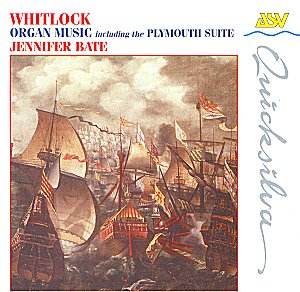
Paul Whiteman, Whithorne, Whittaker, reads my concise Grove, but not a trace of Percy Whitlock (1903-1946). It's certainly not a name I would mention to non-organist friends (the majority!): it isn't that they would be critical; simply no glint of recognition. Yet these same music-lovers could well respond positively to such a piece as Fidelis from the Four Extemporisations played as a Voluntary before Cathedral Evensong.
Perhaps the moral is that we organists who love to listen to, and play, Whitlock's music should campaign on his behalf - and yes, there is a Percy Whitlock Trust.
If musical advocacy be required then look no further than this present CD, which contains The Plymouth Suite (played at St. Andrew's Parish Church, Plymouth), together with the Five Short Pieces, Four Extemporisations and Seven Sketches, performed at the Brangwyn Hall, Swansea.
Jennifer Bate presents the 21 tracks involved with the utmost charm and sympathy, painting in the colours of each exquisite miniature with a rainbow of registrations, and glorying in the robust trumpetings of Paean and Fanfare. There is a taking nimbleness in the notoriously tricky Scherzo and Chanty; flying fingers for Pertimento, and the virtuosic Toccata - quite the equal of many of more celebrated French examples of the genre.
So if you are an adventurous music-lover try this CD. I don't think you'll be disappointed. Organists will assuredly love it, and (dare I say, speaking personally?) perhaps learn from it as well.
Reviewer
Andrew Seivewright
and a review of the same disc by Rob Barnett:-
Although in the same series (and bargain price bracket) as the other two ASV QUICKSILVAs this is the only one of the triptych to be dedicated to the works of one composer. Whitlock has come in for quite a bit of attention over the last decade or two. His 1937 symphony for organ and orchestra was revived by Graham Barber and the BBC Welsh SO at St Asaph Cathedral and this, in turn, seems to have lead to at least two other concert revivals the latest of which was this summer (1999) at York Minster. The same artists recorded the piece at the Minster and this is due to be issued on CD by AMPHION RECORDINGS during 2000.
There have been several small label recitals dedicated to Whitlock's organ works. Sadly his orchestral works have been neglected. There were a number of suites and overtures - possibly light in character (he was for many years a sort of 'composer in residence' at Dan Godfrey's Bournemouth).
Whitlock is also much associated with Devon's 'other capital' (Exeter claims pride of place), Plymouth. Plymouth's St Andrews Parish Church (next to the Guildhall, off Royal Parade) was the venue during the early 1980s for a collaboration between Bob Auger and Ms Bate in which she played the Plymouth Suite (1937) - contemporaneous with the symphony though lighter in tone. The suite is in five movements: a casual allegro risoluto, a recessed and suitably distant Lantana (so very self-effacing), a jolly shanty called Carillon, Salix - an exercise in English reserve though in touch with the British pastoralists (principally Finzi) and a final and flighty Toccata in the spirit of Icarus.
The other three sets of pieces were recorded more recently and not in Plymouth. The Five Short Pieces (1929) include a jaunty Allegretto, a Holstian (Walking Song or Marching Song) Folk Tune, a Finzian Andante Tranquillo, a Christmassy Scherzo (perhaps Malcolm Arnold had some of the sound-character of this piece in mind when he wrote his own, and sweetest, of Organ Concertos) and a Paean complete with blasting tuba tune.
The Four Extemporisations (1933) start with a Carol (complete with hints of Danny Boy) which achieves both dazzle and subtlety, a Pertimento of Elgarian moth-wing texture, an understated Fidelis and a brightly-lit Fanfare.
The Seven Sketches on Verses of the Psalms include another Finzian piece (Postlude), a Dvorakian Duetto, a fragile and etiolated Plaint, a chipper Exultemus, an Elgarian Preambule, a low key Intermezzo and a concluding Sortie which suggests the brilliance of the new-born light.
Excellent notes by Malcolm Riley of the Whitlock Society (note his Thames biography).
The present album is dedicated to the memory of sound-recordist Bob Auger with whom Jennifer Bate has worked.
An attractively priced (bargain range) issue with some of the most attractive music of the three recitals. We need to hear more Whitlock.
Reviewer
Rob Barnett

Xenakis Oresteia Choirs and ensemble, with Spiros Sakkas (baritone) and Sylvio Gualda (percussion)
Salabert SCD 8906 49'25"
Save around 22% with
Amazon UK
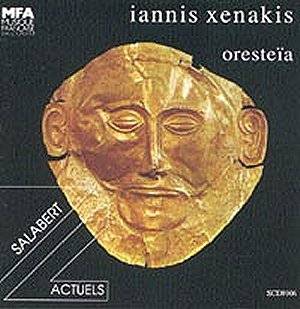
This CD is reviewed in connection with the recent revival at the re-opened Royal Opera House (reviewed in Seen&Heard January 2000). It is a major work of a unique genre. Xenakis looks to Japanese No theatre for an equivalent to the lost Byzantine traditions, with poetry, voice treatment, dance and music combined. His instruments and the movement of sound sources transform the classical tragedy into 'a kind of magical liturgy'. It made a stupendous impression staged at the Linbury Theatre Studio under Guy Protheroe's direction and, years before, in concert performance at the Almeida Festival, with the same the extraordinary Greek baritone (who also screeches in high falsetto) representing Kassandra, the prophetess of doom, as on this CD.
The recording, taken from performances in a Strasbourg church during the 1987 Musica Festival, is resonant and atmospheric. To my ears, it is beautiful, though in a harsh manner, the instruments dominated by brass and percussion, with growling contrabass clarinet and contrabassoon - great, even if some members of the audience at the Opera House departed before the end, short though it is. As Charles Ives said, you need your ears on the right way (or something like that).
A word about presentation. The CD has synopses and a good introduction to this 'harsh celebration of the birth of human justice' but no words or translations, which is regrettable. The Covent Garden programme does have English texts running to eight columns (which opera goers would be unlikely to digest in the interval) and it was played in the dark with no sur-titles. Read again with the CD, they don't quite fit - quite a lot missing, I guess? A pity they couldn't get their act together, and also make this CD available for purchase at the theatre; a rarity, unlikely to be found in the shops, which might have sold like hot cakes. I love it, but you have been warned!
Reviewer
Peter Grahame Woolf

[Part 1]
[Part 2]
[Part 3]
[Part 4]
[thumbnails]
[previous]
 |
Search the Crotchet database from here |
| Discs
on these pages are offered for sale. There is also a page of search
engines from a selection of on-line retailers
here.
Please support this web-site by buying your discs here. Disclaimer: Every effort is made to make sales links to the correct disc but, in the end, you must take responsibility for checking that what you are purchasing is what you want. Some of these discs were not actually available for sale at the time of posting but a link has been made in anticipation of their forthcoming availablility. Any opinions expressed in reviews or articles on this site are those of the author and do not necessarily represent the views of the site owner, Len Mullenger or the Editors. Reviewers and authors retain copyright in their work unless it has been paid for or commissioned by the site owner. All prices, special offers etc relate to the month of publication only or as stated. |
Return to Index of Classical Reviews